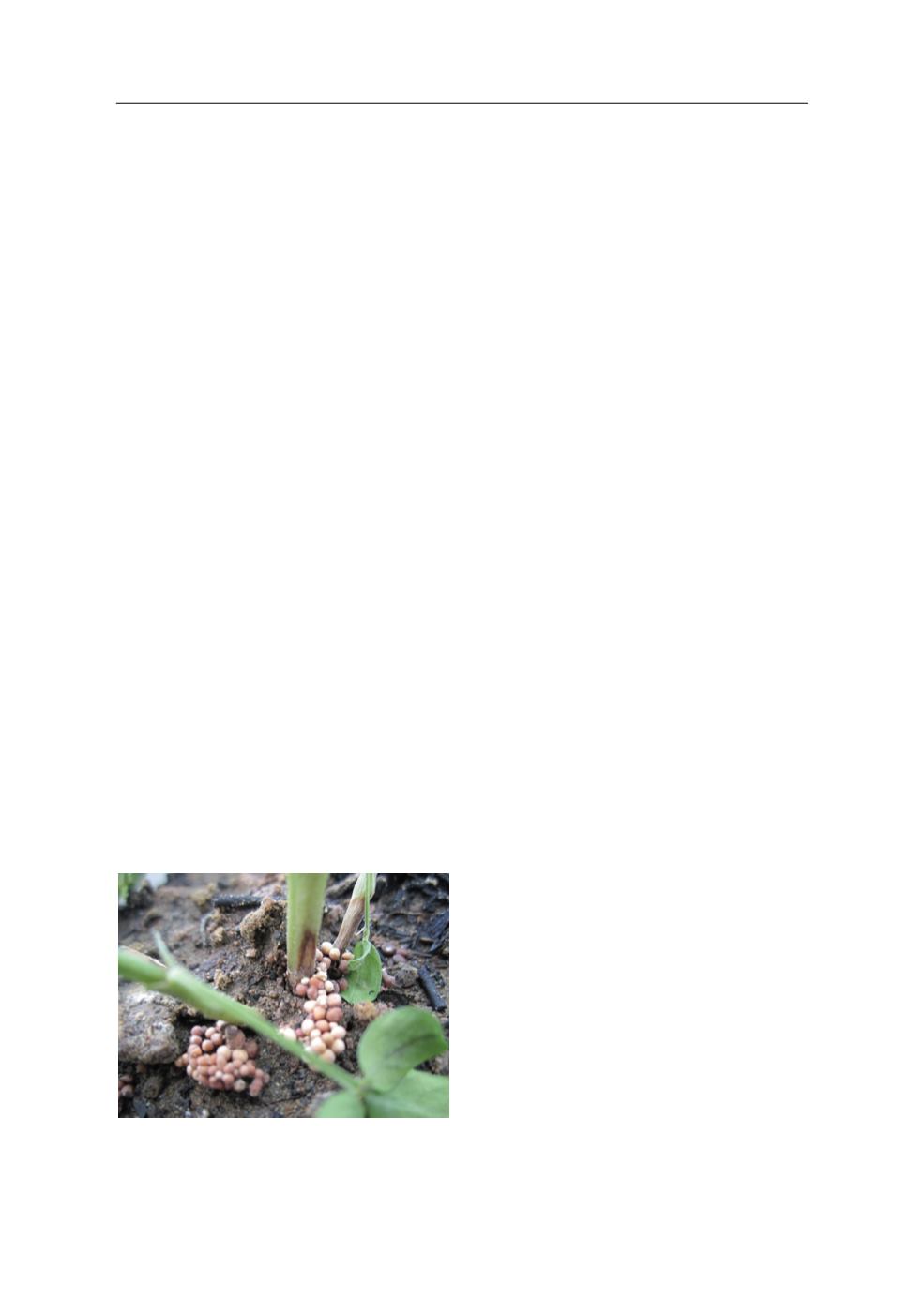
© Benaki Phytopathological Institute
Eslami
et al.
4
Results
S. rolfsii
isolates covered the barley seeds 2-3
weeks after inoculation as white mycelia.
In the isolates virulence determination ex-
periment, two weeks after seeding of pea-
nut germplasm, disease symptoms were ob-
served on peanut seedling stems as water
soaked spots which turned to rot soon (Fig-
ure 1). These spots resulted in wilting and
death of plants during their maturation. The
fungus mycelia extended around the stems
and on the soil surface. Sclerotia were also
observed on these mycelia.
All of the isolates were virulent on tested
peanut germplasm and the virulence was
significantly different within the isolates at
p≤0.01 (Figures 2 and 3). There were signif-
icant differences between the shoot wet
weight and plant height in the treatments
(p≤0.01). The plants which were inoculat-
ed with isolates 8 and 73 were the highest
(33.5 cm) and those inoculated with isolate
64 were the shortest plants (7.33 cm). There
was a significant negative correlation be-
tween plant height and disease severity in-
dex (DSI). The higher was the DSI, the short-
er was the plant height (Table 2).
Stem and root rot resulting from this dis-
ease reduced the shoot wet weight. There
was a significant negative correlation be-
tween shoot wet weight and DSI. The higher
was the DSI, the less was the shoot weight.
Variance analysis of the data related to
stem lesion length showed significant differ-
ence between the isolates (p≤0.01). Isolate 73
caused the shortest lesion (2.35 mm) and iso-
late 53 caused the longest one (100.56 mm).
Stem area affected (%) shows the pro-
portion of the lesion width to the healthy
stem circumference. For the isolates 1, 6, 38,
42, 44, 47, 53, 57, 64, 69 and 70 this propor-
tion was 100%. The least amount was for the
isolates 8 (15%).
Disease symptoms occurrence in an in-
fected plant can be compared with a healthy
control plant and this criterion can be ex-
pressed as percent in an overview. Thus, the
symptoms like wilting, yellowing of the en-
tire leaves or only the lower leaves, occur-
rence of the lesions and crown infection
were evaluated. This criterion was 100% for
isolates 1, 6, 38, 42, 44, 47, 53, 57, 64, 69 and
70 and 16.66% for isolate 8 (Figure 3).
Based on the correlation analysis results,
there was a significant correlation within all
measured criteria at p≤0.01 (Table 2). There
was a significant positive correlationbetween
percent of symptoms occurrence, DSI, stem
lesion length and stem area affected (%), but
a negative correlation between these men-
tioned criteria and plant height and shoot
wet weight. The greater was the amount of
lesion length or stem area affected, the high-
er were the symptoms occurrence and DSI,
the less the plant height and wet weight and
therefore the more virulent the tested iso-
late. When the plants had been infected by
the fungus especially in their seedling stage,
the seedlings lost their normal growth and
the final plant height decreased compared to
uninfected control plants. The isolates which
were more virulent also decreased the pea-
nut seedlings emergence rate more.
The 78 tested isolates in this study were
significantly different in their virulence on
the tested peanut germplasm and were di-
vided to five groups based on their viru-
lence (P≤0.01). The isolates 38, 6, 1, 42, 44, 47,
53, 57, 64, 69 and 70 were the most virulent
and the isolates 8 and 73 were the least viru-
lent ones. Considering the calculated DSI for
each isolate, the tested peanut germplasm
reaction to these isolates was expressed as
Figure 1.
Stem lesion caused by a virulent isolate of
Sclero-
tium rolfsii
on a susceptible local peanut germplasm. The scle-
rotia produced on the infected stem and on the soil surface.


